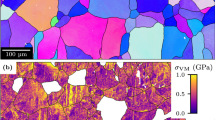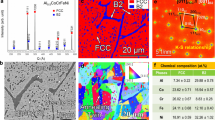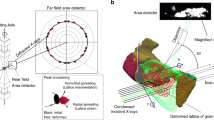Abstract
There have been numerous efforts to understand and control the resistance of materials to fracture by repeated or cyclic stresses. The micromechanical behaviours, particularly the distributions of stresses on the scale of grain size during or after mechanical or electrical fatigue, are crucial to a full understanding of the damage mechanisms in these materials. Whether a large microstress develops during cyclic deformation with a small amount of monotonic strain but a large amount of accumulated strain remains an open question. Here, we report a neutron diffraction investigation of the development of intergranular stresses, which vary as a function of grain orientations, in 316 stainless steel during high-cycle fatigue. We found that a large intergranular stress developed before cracks started to appear. With further increase of fatigue cycles, the intergranular stress decreased, while the elastic intragranular stored energy continued to grow. One implication of our findings is that the ratio between the intergranular and intragranular stored energies during various stages of fatigue deformation may validate the damage mechanism and can be used as a fingerprint for monitoring the state of fatigue damage in materials.
This is a preview of subscription content, access via your institution
Access options
Subscribe to this journal
Receive 12 print issues and online access
$259.00 per year
only $21.58 per issue
Buy this article
- Purchase on Springer Link
- Instant access to full article PDF
Prices may be subject to local taxes which are calculated during checkout




Similar content being viewed by others
References
Dawson, P., Boyce, D., MacEven, S. & Rogge, R., Residual strain in HY100 polycrystals: comparisons of experiments and simulations. Metall. Trans. A 31, 1543–1555 (2000).
Clausen, B., Lorentz, T. & Leffers, T. Self-consistent modelling of the plastic deformation of f.c.c polycrystals and its implications for diffraction measurements of internal stresses. Acta Mater. 46, 3087–3098 (1998).
Pang, J.W.L., Holden, T.M. & Mason, T.E. In situ generation of intergranular strains in an Al7050 alloy. Acta Mater. 46, 1503–1518 (1998).
Lorentzen, T., Daymond, M.R., Clausen, B. & Tome, C.N. Lattice strain evolution during cyclic loading of stainless steel. Acta Mater. 50, 1627–1638 (2002).
Korsunsky, A.M. & James, K.E. Intergranular stress evolution in fcc polycrystals during high cycle fatigue. ISIS Annual Report (2001) RB No. 12180. http://www.isis.rl.ac.uk/isis2001.
Margulies, L., Winther, G. & Poulsen, H.F. In situ measurement of grain rotation during deformation of polycrystals. Science 291, 2392–2394 (2001).
Larson, B.C., Yang, W., Ice, G.E., Budai, J.D. & Tischler, J.Z. X-ray structural microscopy with submicrometre resolution. Nature 415, 887–890 (2002).
Wang, Y.D., Lin Peng, R. & McGreevy, R.L. A novel method for constructing the mean field of grain-orientation-dependent residual stress. Phil. Mag. Lett. 81, 153–163 (2001).
Wang, Y.D., Lin Peng, R., Wang, X.-L. & McGreevy, R.L. Grain-orientation-dependent residual stress and the effect of annealing in cold-rolled stainless steel. Acta Mater. 50, 1717–1734 (2002).
Behnken, H. Strain-function method for the direct evaluation of intergranular strains and stresses. Phys. Status Solidi A 177, 401–418 (2000).
Mansur, L.K., Gabriel, T.A., Haines, J.R. & Lousteau, D.C. R&D for the Spallation Neutron Source mercury target. J. Nucl. Mater. 296, 1–16 (2001).
Tian, H. et al. Influence of mercury environment on the fatigue behaviour of spallation neutron source (SNS) target container materials. Mater. Sci. Eng. 314, 140–149 (2001).
Strizak, J.P., DiStefano, J.R., Liaw, P.K. & Tian, H. The effect of mercury on the fatigue behaviour of 316 LN stainless steel. J. Nucl. Mater. 296, 225–230 (2001).
Wang, Y.D., Wang, X.-L., Stoica, A.D., Richardson, J.W. & Lin Peng, R. Determination of the stress orientation distribution function using pulsed neutron sources. J. Appl. Cryst. 36, 14–22 (2003).
Quesnel, D.J. & Meshii, M. The response of high-strength low alloy steel to cyclic plastic deformation. Mater. Sci. Eng. 30, 223–241 (1977).
Quesnel, D.J., Meshii, M. & Cohen, J.B. Residual stresses in high strength low alloy steel during low cycle fatigue. Mater. Sci. Eng. 36, 207–215 (1978).
Noyan, I.C. & Cohen, J.B. X-ray-diffraction study of changes in stress-strain distributions during the fatigue of a 2-phase alloy. Mater. Sci. Eng. 79, 149–155 (1986).
Winholtz, R.A. & Cohen, J.B. Changes in the macrostresses and microstresses in steel with fatigue. Mater. Sci. Eng. A 154, 155–163 (1992).
Holden, T.M., Holt, R.A. & Clarke, A.P. Intergranular stresses in Incoloy-800. J. Neutron Res. 5, 241–264 (1997).
Borbely, A., Driver, J.H. & Ungar, T. X-ray method for the determination of stored energy in texture components of deformed metals; application to cold worked ultra high purity iron. Acta Mater. 48, 2005–2016 (2000).
Ungar, T., Dragomir, I., Revesz, A. & Borbely, A. The contrast factors of dislocations in cubic crystals: the dislocation model of strain anisotropy in practice. J. Appl. Cryst. 32, 992–1002 (1999).
Laird, C. in Physical Metallurgy vol. 3 (eds Cahn R.W. & Haasen P.) 2293–2397 (Elsevier Science, Amsterdam, 1996).
Suresh, S. Fatigue of Materials (Cambridge Univ. Press, Cambridge, 1998).
Guiu, F. & Dulniak, R. On the nucleation of fatigue cracks in pure polycrystalline α-iron. Fatigue Fract. Eng. Mater. Struct. 5, 311–321 (1982).
Pommier, S. hing' effect in elastic polycrystals: implications for the variability of fatigue lives. Fatigue Fract. Eng. Mater. Struct. 25, 331–348 (2002).
Le Biavant, K., Pommier, S. & Prioul, C. Local texture and fatigue initiation in a Ti-6Al-4V titanium alloy. Fatigue Fract. Eng. Mater. Struct. 25, 527–545 (2002).
Zhang, Y. & Jiang, Q. Twinning-induced stress and electric field concentrations in ferroelectric ceramics. J. Am. Ceram. Soc. 78, 3290–3296 (1995).
Wang, X.-L., Wang, Y.D. & Richardson, J.W. Experimental error caused by sample displacement in time-of-flight neutron diffractometery. J. Appl. Cryst. 35, 533–537 (2002).
Acknowledgements
We thank E. Maxey for assistance in the experiment. This research was sponsored by the US Department of Energy, Division of Materials Sciences and Engineering, under Contract DE-AC05-00OR22725 with Oak Ridge National Laboratory managed by UT-Battelle. The neutron diffraction work has benefitted from the use of the Intense Pulsed Neutron Source at Argonne National Laboratory, which is funded by the US Department of Energy, BES-Materials Science, under Contract No. W-31-109-ENG-38. This research was also supported in part by an appointment to the Oak Ridge National Laboratory Postdoctoral Research Associates Program administered by the Oak Ridge Institute for Science and Education, and by the US National Science Foundation, the Combined Research and Curriculum Development (CRCD) Program, under EEC-9527527, with M. Poats as the contract monitor, and the Integrative Graduate Education and Research Training (IGERT) Program, under DGE-9987548, with W. Jennings and L. Goldberg as contract monitors. HT and PKL thank L. Mansur and J. Strizak of the Oak Ridge National Laboratory for their kind support of HT's Ph.D. thesis research related to fatigue behaviour of Type 316 stainless steel for the application of the target container materials of the Spallation Neutron Source.
Author information
Authors and Affiliations
Corresponding authors
Ethics declarations
Competing interests
The authors declare no competing financial interests.
Rights and permissions
About this article
Cite this article
Wang, YD., Tian, H., Stoica, A. et al. The development of grain-orientation-dependent residual stressess in a cyclically deformed alloy. Nature Mater 2, 101–106 (2003). https://doi.org/10.1038/nmat812
Received:
Accepted:
Published:
Issue Date:
DOI: https://doi.org/10.1038/nmat812
This article is cited by
-
Experimental Investigation on Permeability and Mechanical Properties of Cement–Salt Rock Interface Subjected to Cyclic Loading
Rock Mechanics and Rock Engineering (2023)
-
High Temperature Deformation Mechanism in Hierarchical and Single Precipitate Strengthened Ferritic Alloys by In Situ Neutron Diffraction Studies
Scientific Reports (2017)
-
Relating Residual Stress and Substructural Evolution During Tensile Deformation of an Aluminum-Manganese Alloy
Metallurgical and Materials Transactions A (2017)
-
Ferritic Alloys with Extreme Creep Resistance via Coherent Hierarchical Precipitates
Scientific Reports (2015)
-
Defective twin boundaries in nanotwinned metals
Nature Materials (2013)



